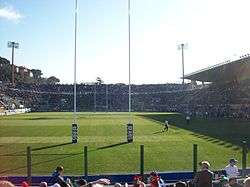Stadio Flaminio
| Flaminio | |
 | |
| Location |
Viale dello Stadio Flaminio I-00196 Rome |
|---|---|
| Coordinates | 41°55′37.04″N 12°28′20.28″E / 41.9269556°N 12.4723000°ECoordinates: 41°55′37.04″N 12°28′20.28″E / 41.9269556°N 12.4723000°E |
| Owner | Municipality of Rome |
| Operator | Italian Football Federation |
| Capacity | 30,000 |
| Surface | Grass |
| Construction | |
| Broke ground | 1957 |
| Opened | 1959 |
| Renovated | 2008 |
| Construction cost | approx. 900 mln Lire |
| Architect | Antonio Nervi |
| Structural engineer | Pier Luigi Nervi |
| Services engineer | Ingg. Nervi & Bartoli |
| Tenants | |
|
Capitolina Marines Lazio Football Italy national rugby union team (2000–2011) | |
The Stadio Flaminio is a stadium in Rome. It lies along the Via Flaminia, three kilometres northwest of the city centre, 300 metres away from the Parco di Villa Glori.
The interior spaces include a covered swimming pool, rooms for fencing, amateur wrestling, weightlifting, boxing and gymnastics.
History
Pier Luigi Nervi designed the Flaminio Stadium with his son, the architect Antonio Nervi, between 1957 and 1958. The structure was built for the XVII Olympic Games in Rome (1960) and inaugurated in 1959. The Stadio Flaminio was built on the site of the previous Stadio Nazionale PNF. It was mostly devoted to football matches and served as the venue for the football final in the 1960 Summer Olympics.[1]
This stadium is a remarkable example of different ways to use concrete : in situ castings, prefabricated elements, undulating slabs of ferrocement.[2] The Flaminio Stadium is a unique work that offers a highly original union between form and structure and between architecture and engineering. It testifies to a special and internationally recognised period for Italian architectural culture, characterised by a highly fertile relationship between different disciplines. The project also frames a unique moment in the work of Pier Luigi Nervi, unanimously recognised as the most ingenious Italian engineer and a pioneer of the study and use of reinforced concrete.
Abandoned for years, the stadium is now in an advanced state of decay. This degeneration can be traced back to three principal causes: improper interventions that failed to respect the characteristics of the original structure, widespread deterioration caused by years of neglect and the physiological aging of materials and plant systems.
In July 2017, with the cooperation of the Municipality of Rome, Sapienza University, Pier Luigi Nervi Project Association and DO.CO.MO.MO. Italy received a grant from the Getty Foundation and its Keeping if Modern program to prepare a conservation plan for the Stadio Flaminio.[3]
Events
Pink Floyd performed two concerts on 11 and 12 July 1988 during their A Momentary Lapse of Reason Tour.
Michael Jackson performed two sell-out concerts on 23 and 24 May 1988 during his Bad World Tour. Each concert was attended by a crowd of 35,000 fans. Police and security guards rescued hundreds of fans from being crushed in the crowd. Jackson also performed another sell-out concert on 4 July 1992 during the Dangerous World Tour, in front of 35,000 fans.
Rugby
It was the home of Italy rugby union national team for Six Nations tournament home matches from Italy's entry in the competition in 2000 until 2011.
The Italian Rugby Federation (FIR) announced, in January 2010, that the stadium would undergo an expansion, that will increase its capacity to 42,000, before the 2012 Six Nations Championship.[4] A failure to progress these plans has been cited as the reason for moving Italy's home Six Nations games from 2012.[5] With a capacity of 32,000 (8,000 covered), it was the smallest of the Six Nations stadiums. It is no longer considered big enough for the Italian national team and there were frequent reports[4] that the national team would move to Genoa or to the Stadio Olimpico di Roma. This change was confirmed with the Italian Rugby Federation (FIR) becoming upset at broken promises of renovations. It was initially reported that the FIR would move Six Nations matches to Stadio Artemio Franchi in Florence.[5] However, when the city finally began the promised renovations, FIR announced that it would instead keep its Six Nations home fixtures in Rome at Stadio Olimpico,[6] and that it would return to the Flaminio once the project is completed.[7]
The stadium was originally slated to become the home of Praetorians Roma, a newly formed team that would be one of Italy's two representatives in the Celtic League.[8] However, it was later decided that Benetton Treviso would replace Praetorians.[9]
Football
In 1989–90 season both Roma and Lazio played at Stadio Flaminio during the renovations of Stadio Olimpico.[10] Stadio Flaminio was also the home of Atletico Roma F.C., an association football club who played in Lega Pro Prima Divisione, but were dissolved in 2011.
References
- ↑ 1960 Summer Olympics official report. Volume 1. pp. 58, 60.
- ↑ The Flaminio Stadium by Pier Luigi and Antonio Nervi in Rome: an interdisciplinary conservation plan Pier Luigi Nervi Research and Knowledge Management Project, July 2017
- ↑ Keeping It Modern: 2017 Grants Awarded Getty Foundation, July 2017
- 1 2 "Stadio Flaminio set for re-vamp". Scrum.com. 30 January 2010. Retrieved 21 August 2010.
- 1 2 "Italy to move Six Nations games from Rome to Florence". BBC Sport. 1 April 2011. Retrieved 2 April 2011.
- ↑ "RBS 6 Nazioni, allo Stadio Olimpico l'Edizione 2012" (Press release) (in Italian). Italian Rugby Federation. 13 July 2011. Retrieved 10 August 2011.
- ↑ Sportsbeat (14 July 2011). "Italy switch stadium to Stadio Olimpico". RBS 6 Nations. Archived from the original on 13 September 2011. Retrieved 6 September 2011.
- ↑ "Italians pick Celtic League teams". BBC Sport. 18 July 2009. Retrieved 18 July 2009.
- ↑ "Il Veneto in Celtic League, Roma fuori" (in Italian). Rugby Veneto. 2 September 2009. Retrieved 6 September 2009.
- ↑ http://www.stadiodi.it/flaminio-roma/
| Preceded by Melbourne Cricket Ground Melbourne |
Summer Olympics Football Men's Finals (Stadio Flaminio) 1960 |
Succeeded by National Stadium Tokyo |
